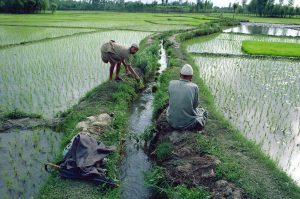
Abrar Ahmad Khan
The ideal equilibrium which the nature has bestowed among various environmental domains has been deteriorated by the unchecked human activities of the contemporary era. This, along with other furies has led to the gravest situation in the current pandemic of COVID-19.
Agriculture is the main economic activity of the Kashmir valley and contributes 21% to GDP of J&K and 70-80% of the population directly or indirectly depends on it, therefore should not suffer as also directed by Govt. of India that the agriculture activities should go on by following standard operating procedures (SOPs).
Although paddy being the staple food crop of Kashmir valley, its cultivation has reduced drastically owing to conversion of paddy land into horticulture, particularly apple cultivation and other non-agricultural purposes. The lower yield of the existing conventional varieties of paddy mostly used by the farmers also adds to the problem. Over the years, scientists of SKUAST Kashmir particularly, MRCFC Khudwani station have developed a number of rice varieties suitable for varied topographies of the valley. The important to mention is the Shalimar series (SR-1, SR-2, SR-3, SR-4 and SR-5) which are high yielding, resistant to lodging, diseases and pests. The full potential of these varieties can only be exploited if recommended management practices are followed.
Paddy cultivation starts with the establishment of paddy nursery. For an area of 1 Kanal of land we require an area of 1 marla for nursery which should be well puddled and weed free. Nursery should always be prepared in strips 1 meter wide and of any convenient length. Bed area should be ploughed 2-3 times to bring the soil to fine tilth with removal of weeds and stubbles of the previous crop and levelled so that 2-3 cm of uniform water layer is maintained in the nursery. Apply 40-50kg FYM, 12.5 kg ash, 275 grams of urea, 450 grams of DAP and 200 grams of MOP per marla right at the time of soil preparation of nursery bed.
For the successful cultivation of any crop seed is the basic input and production/productivity is directly proportional to the quality of seed, thus it should be healthy and disease. Self selected seed of previous crop needs seed treatment (Organic or Inorganic) before sowing. Among the inorganic treatments, use Tricyclozole or Carbendazim 6g/10 litre and 1g/litre of water respectively, by soaking the seed in the solution for 10-20 minutes. Soaked seeds should be shade dried before sowing. Whereas, in organic seed treatment, we use Tricoderma spp., Phosphobacteria, Pseudomonos etc. @10g/kg seed. However the seed procured from the agriculture departmental stores stands chemically treated and need not be treated again.
Temperature fluctuations during the month of April and first fortnight of May due to spring rainfall often leads to week nursery and sometimes even complete failure of the nursery. In order to avoid this risk and uncertainty, Protected nurseries are recommended over conventional ones. In protected nurseries, seed bed is covered with polythene sheets placed on fixed willow sticks in such a way that a low tunnel is created. During day time if it is sunny remove the sheets by rolling and cover the same if it is rainy or cloudy. Keep the nursery covered during night for at least first 15 days.
The ideal sowing time in the Kashmir valley for paddy nursery is 3rd week of April to 1st fortnight of May. Seed should be soaked in water for 24 hours before incubation; chaff and partially filled seeds should be removed at the time of soaking. Incubate the seeds for 24-36 hours. Broadcast pre germinated seeds @3 kg/Kanal in lower belts and 4 kg/Kanal in higher belts and maintain 2-3 cm uniform water layer till establishment of the same. Weeds pose a serious threat for yield reduction by 15-20%. In order to keep the growth of weeds in check, proper hand weeding at the time of bed preparation followed by application of pre-emergence herbicides like Butachlor 75g/marla, Pretilachlor 2ml/litre of water or Oxadiargyl 5.5 g/kanal of nursery area 3-5 DAS gives good results. With regard to irrigation, it is to be mentioned that the use of cold water leads to major abiotic constraint of cold injury which severely restricts the growth of the seedlings and sometimes even death. In order to avoid this stress, farmers should dig small pits of suitable size around the nursery for storage the water. The water stored will get heated up by sunlight during the day and the same should be used in the evening for irrigating the nursery.
Sometimes there is algal bloom in the seed bed which may be due to the use of undecomposed organic matter, improper incorporation of fertilisers especially DAP and use of muddy water for irrigation. It can be controlled by draining out water from the bed and if algal growth is visible apply copper sulphate @0.5 g and lime 0.5 g per litre of water and drench with the same after drainage of the previous water. In case yellowing of the seedlings is noticed drain out water for few days and apply 250 grams urea per marla of nursery area. The seedlings are ready for transplanting in 25-35 days after sowing and should be transplanted with utmost care without damaging the root system of the seedlings.
Blast is the principle disease of paddy in the valley which occurs at nursery stage also. It can be controlled by seed treatment as mentioned above in endemic areas. In case it appears in the nursery spray Tricyclozole 75 WP @0.6g/litre of water or Propiconazole 25 EC @1ml/litre of water or Carbendazim 50 WP @ 1 g/liter of water. Among the pests infesting the nursery paddy snails, army worm and cray fish are worth to mention. Paddy snails and cray fish can be controlled by releasing ducks into the nursery before sowing the seed, preventing their entry into the nursery by using sieve at the point of entry of water and by applying copper sulphate+lime (2:5) @ 0.5 kg/kanal or Chlorpyriphos 10 G @ 1kg/kanal. For army worm use Dimethoate 30 EC @ 1 ml/litre of water or Phosolone 35 EC @1.4 ml/litre of water
Author is an Agronomist and works as Junior Agriculture Extension Officer, Department of Agriculture, Govt. of J&K. He can be reached at: [email protected]
Follow this link to join our WhatsApp group: Join Now
Be Part of Quality Journalism |
Quality journalism takes a lot of time, money and hard work to produce and despite all the hardships we still do it. Our reporters and editors are working overtime in Kashmir and beyond to cover what you care about, break big stories, and expose injustices that can change lives. Today more people are reading Kashmir Observer than ever, but only a handful are paying while advertising revenues are falling fast. |
| ACT NOW |
| MONTHLY | Rs 100 | |
| YEARLY | Rs 1000 | |
| LIFETIME | Rs 10000 | |










